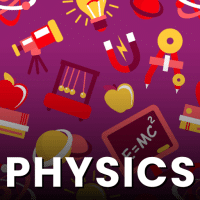Class 12 Exam > Class 12 Questions > Why does current flow in the forward-bias dir...
Start Learning for Free
Why does current flow in the forward-bias direction but not flow in the reverse-bias direction in a pn junction?
- a)The anode is negative.
- b)Minority carriers are pushed to the junction.
- c)Majority carriers are pushed to the junction.
- d)The intrinsic carriers are removed.
Correct answer is option 'C'. Can you explain this answer?
Verified Answer
Why does current flow in the forward-bias direction but not flow in th...
The PN junction has the very useful property that electrons are only able to flow in one direction. As current consists of a flow of electrons, this means that current is allowed to flow only in one direction across the structure, but it is stopped from flowing in the other direction across the junction.
View all questions of this test
Most Upvoted Answer
Why does current flow in the forward-bias direction but not flow in th...
Why does current flow in the forward-bias direction but not flow in the reverse-bias direction in a pn junction?
In a pn junction, the flow of current depends on the biasing condition applied to the junction. A pn junction can be operated in two biasing conditions: forward bias and reverse bias. In the forward-bias condition, the positive terminal of the battery is connected to the p-region (anode) and the negative terminal is connected to the n-region (cathode). Conversely, in the reverse-bias condition, the positive terminal is connected to the n-region while the negative terminal is connected to the p-region.
The reason why current flows in the forward-bias direction but not in the reverse-bias direction can be explained by the behavior of majority and minority charge carriers in the pn junction.
Majority carriers pushed to the junction:
In a pn junction, there are two types of charge carriers: majority carriers and minority carriers. Majority carriers are the dominant charge carriers in each region, while minority carriers are present in smaller quantities. In the p-region, the majority carriers are holes, and in the n-region, the majority carriers are electrons.
When a pn junction is forward-biased, the positive terminal of the battery repels the holes in the p-region, and the negative terminal repels the electrons in the n-region. This repulsion force pushes the majority carriers towards the junction.
Minority carriers pushed to the junction:
In addition to the majority carriers, there are also minority carriers present in both regions. In the p-region, the minority carriers are electrons, and in the n-region, the minority carriers are holes. In the forward-bias condition, the repulsion force applied by the external battery also pushes the minority carriers towards the junction.
Combining the effect of majority and minority carriers, both types of charge carriers are pushed towards the pn junction in the forward-bias condition. This results in an accumulation of charge carriers near the junction, creating a region of high charge density.
The intrinsic carriers are removed:
On the other hand, in the reverse-bias condition, the positive terminal of the battery attracts the electrons in the n-region, and the negative terminal attracts the holes in the p-region. This attraction force pulls the majority carriers away from the junction, creating a depletion region with a low charge density. Additionally, the reverse-bias voltage also increases the width of the depletion region.
In this condition, the minority carriers are not actively pushed towards the junction. Instead, they are effectively removed from the junction region due to the widening of the depletion region. As a result, there is a lack of charge carriers near the junction, preventing the flow of current.
Therefore, the correct answer is option C: Majority carriers are pushed to the junction.
In a pn junction, the flow of current depends on the biasing condition applied to the junction. A pn junction can be operated in two biasing conditions: forward bias and reverse bias. In the forward-bias condition, the positive terminal of the battery is connected to the p-region (anode) and the negative terminal is connected to the n-region (cathode). Conversely, in the reverse-bias condition, the positive terminal is connected to the n-region while the negative terminal is connected to the p-region.
The reason why current flows in the forward-bias direction but not in the reverse-bias direction can be explained by the behavior of majority and minority charge carriers in the pn junction.
Majority carriers pushed to the junction:
In a pn junction, there are two types of charge carriers: majority carriers and minority carriers. Majority carriers are the dominant charge carriers in each region, while minority carriers are present in smaller quantities. In the p-region, the majority carriers are holes, and in the n-region, the majority carriers are electrons.
When a pn junction is forward-biased, the positive terminal of the battery repels the holes in the p-region, and the negative terminal repels the electrons in the n-region. This repulsion force pushes the majority carriers towards the junction.
Minority carriers pushed to the junction:
In addition to the majority carriers, there are also minority carriers present in both regions. In the p-region, the minority carriers are electrons, and in the n-region, the minority carriers are holes. In the forward-bias condition, the repulsion force applied by the external battery also pushes the minority carriers towards the junction.
Combining the effect of majority and minority carriers, both types of charge carriers are pushed towards the pn junction in the forward-bias condition. This results in an accumulation of charge carriers near the junction, creating a region of high charge density.
The intrinsic carriers are removed:
On the other hand, in the reverse-bias condition, the positive terminal of the battery attracts the electrons in the n-region, and the negative terminal attracts the holes in the p-region. This attraction force pulls the majority carriers away from the junction, creating a depletion region with a low charge density. Additionally, the reverse-bias voltage also increases the width of the depletion region.
In this condition, the minority carriers are not actively pushed towards the junction. Instead, they are effectively removed from the junction region due to the widening of the depletion region. As a result, there is a lack of charge carriers near the junction, preventing the flow of current.
Therefore, the correct answer is option C: Majority carriers are pushed to the junction.
Free Test
FREE
| Start Free Test |
Community Answer
Why does current flow in the forward-bias direction but not flow in th...
C

|
Explore Courses for Class 12 exam
|

|
Question Description
Why does current flow in the forward-bias direction but not flow in the reverse-bias direction in a pn junction?a)The anode is negative.b)Minority carriers are pushed to the junction.c)Majority carriers are pushed to the junction.d)The intrinsic carriers are removed.Correct answer is option 'C'. Can you explain this answer? for Class 12 2025 is part of Class 12 preparation. The Question and answers have been prepared according to the Class 12 exam syllabus. Information about Why does current flow in the forward-bias direction but not flow in the reverse-bias direction in a pn junction?a)The anode is negative.b)Minority carriers are pushed to the junction.c)Majority carriers are pushed to the junction.d)The intrinsic carriers are removed.Correct answer is option 'C'. Can you explain this answer? covers all topics & solutions for Class 12 2025 Exam. Find important definitions, questions, meanings, examples, exercises and tests below for Why does current flow in the forward-bias direction but not flow in the reverse-bias direction in a pn junction?a)The anode is negative.b)Minority carriers are pushed to the junction.c)Majority carriers are pushed to the junction.d)The intrinsic carriers are removed.Correct answer is option 'C'. Can you explain this answer?.
Why does current flow in the forward-bias direction but not flow in the reverse-bias direction in a pn junction?a)The anode is negative.b)Minority carriers are pushed to the junction.c)Majority carriers are pushed to the junction.d)The intrinsic carriers are removed.Correct answer is option 'C'. Can you explain this answer? for Class 12 2025 is part of Class 12 preparation. The Question and answers have been prepared according to the Class 12 exam syllabus. Information about Why does current flow in the forward-bias direction but not flow in the reverse-bias direction in a pn junction?a)The anode is negative.b)Minority carriers are pushed to the junction.c)Majority carriers are pushed to the junction.d)The intrinsic carriers are removed.Correct answer is option 'C'. Can you explain this answer? covers all topics & solutions for Class 12 2025 Exam. Find important definitions, questions, meanings, examples, exercises and tests below for Why does current flow in the forward-bias direction but not flow in the reverse-bias direction in a pn junction?a)The anode is negative.b)Minority carriers are pushed to the junction.c)Majority carriers are pushed to the junction.d)The intrinsic carriers are removed.Correct answer is option 'C'. Can you explain this answer?.
Solutions for Why does current flow in the forward-bias direction but not flow in the reverse-bias direction in a pn junction?a)The anode is negative.b)Minority carriers are pushed to the junction.c)Majority carriers are pushed to the junction.d)The intrinsic carriers are removed.Correct answer is option 'C'. Can you explain this answer? in English & in Hindi are available as part of our courses for Class 12.
Download more important topics, notes, lectures and mock test series for Class 12 Exam by signing up for free.
Here you can find the meaning of Why does current flow in the forward-bias direction but not flow in the reverse-bias direction in a pn junction?a)The anode is negative.b)Minority carriers are pushed to the junction.c)Majority carriers are pushed to the junction.d)The intrinsic carriers are removed.Correct answer is option 'C'. Can you explain this answer? defined & explained in the simplest way possible. Besides giving the explanation of
Why does current flow in the forward-bias direction but not flow in the reverse-bias direction in a pn junction?a)The anode is negative.b)Minority carriers are pushed to the junction.c)Majority carriers are pushed to the junction.d)The intrinsic carriers are removed.Correct answer is option 'C'. Can you explain this answer?, a detailed solution for Why does current flow in the forward-bias direction but not flow in the reverse-bias direction in a pn junction?a)The anode is negative.b)Minority carriers are pushed to the junction.c)Majority carriers are pushed to the junction.d)The intrinsic carriers are removed.Correct answer is option 'C'. Can you explain this answer? has been provided alongside types of Why does current flow in the forward-bias direction but not flow in the reverse-bias direction in a pn junction?a)The anode is negative.b)Minority carriers are pushed to the junction.c)Majority carriers are pushed to the junction.d)The intrinsic carriers are removed.Correct answer is option 'C'. Can you explain this answer? theory, EduRev gives you an
ample number of questions to practice Why does current flow in the forward-bias direction but not flow in the reverse-bias direction in a pn junction?a)The anode is negative.b)Minority carriers are pushed to the junction.c)Majority carriers are pushed to the junction.d)The intrinsic carriers are removed.Correct answer is option 'C'. Can you explain this answer? tests, examples and also practice Class 12 tests.

|
Explore Courses for Class 12 exam
|

|
Signup for Free!
Signup to see your scores go up within 7 days! Learn & Practice with 1000+ FREE Notes, Videos & Tests.























